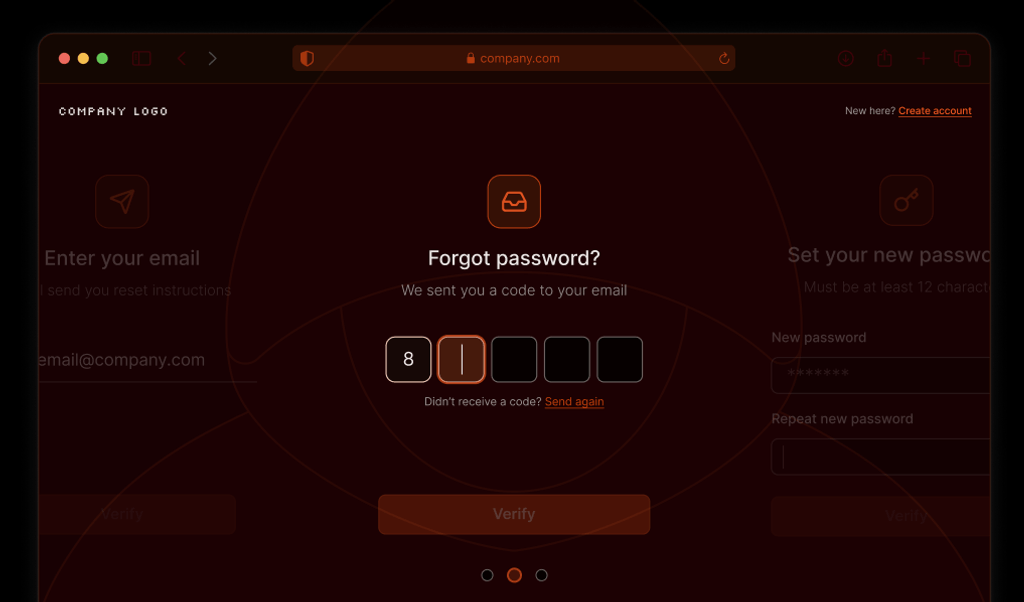
Summarize this article with
Man-in-the-middle attack (MitM) prevention is a must for anyone building or securing web applications. MitM attacks let attackers intercept, manipulate, or steal data as it moves between users and servers. If you’re responsible for API traffic, user sessions, or just making sure your company doesn’t end up in the news for the wrong reasons, you need to understand how these attacks work and how to stop them.
The consequences of a successful MitM attack are serious: stolen credentials, account takeover, intercepted sessions, financial fraud, and a reputation that takes a long time to repair.
What is a man-in-the-middle attack?
A man-in-the-middle attack happens when an attacker secretly sits between two parties who think they’re communicating directly. The attacker intercepts messages, manipulates data, or impersonates one of the parties. The victim is usually unaware, assuming their connection is secure.
Why man-in-the-middle attack prevention matters
Every bit of data traveling between your users and your servers is a potential target. MitM attacks can quietly siphon off login credentials, session tokens, or payment details without anyone noticing. For organizations, this is a direct threat to user trust and business continuity.
When attackers get authentication tokens or credentials, account takeover becomes nearly effortless. Intercepted sessions can lead to unauthorized transactions, data leaks, or even complete system compromise. And when users find out their information was exposed, the fallout is fast and ugly. If you’re building or maintaining applications, man-in-the-middle attack prevention is not optional.
How man-in-the-middle attacks work
The mechanics are straightforward but dangerous. The attacker intercepts traffic, reads or modifies it, then passes it along. This can mean eavesdropping on messages, injecting malicious code, or stealing session tokens. The attacker might impersonate the server to the client, the client to the server, or both.
Common types of MitM attacks
Attackers have plenty of MitM techniques. Here are the most common ways they sneak into your data streams:
SSL stripping
SSL stripping downgrades secure HTTPS connections to unencrypted HTTP. The attacker intercepts the initial connection and serves up a fake, insecure version of the site, while maintaining a secure connection to the real server. The user thinks they’re safe, but their data is transmitted in plaintext. This is especially risky on public networks or sites that don’t enforce HTTPS everywhere.
Wi-Fi hijacking and rogue access points
Public Wi-Fi is a playground for MitM attackers. They set up rogue access points with names that look legitimate (like “CoffeeShop_WiFi” instead of “CoffeeShopWiFi”), often called “evil twins”. Users connect, and all their traffic flows through the attacker’s hardware. Even on real networks, attackers can use ARP spoofing to redirect traffic through their device, capturing anything that isn’t encrypted.
ARP spoofing
On local networks, attackers use ARP (Address Resolution Protocol) spoofing to convince devices that the attacker’s machine is the gateway to the Internet. All local traffic flows through the attacker, who can intercept or modify data before passing it on. This is a classic move on shared networks like offices, hotels, or coffee shops.
DNS spoofing and cache poisoning
DNS spoofing tricks users into connecting to attacker-controlled servers by providing fake DNS responses. Cache poisoning corrupts DNS records at the resolver level, potentially affecting entire networks. Once users are pointed to the wrong IP address, attackers can impersonate legitimate sites and harvest credentials or inject malware.
Session hijacking
Session hijacking is the art of stealing session tokens — those bits of data that prove a user is logged in. Once an attacker has a session token, they can impersonate the user without knowing the password. This is especially dangerous for applications that don’t rotate tokens or use secure cookie attributes.
SSL/TLS hijacking (HTTPS spoofing)
SSL/TLS hijacking is a MitM technique where an attacker intercepts your HTTPS connection, often after using ARP or DNS spoofing, and presents a forged certificate for the target domain. Because the attacker has installed a malicious CA in the victim’s trust store, the browser accepts it as legit. This lets the attacker silently decrypt and re‑encrypt your traffic, giving them full access to sensitive data without triggering browser warnings.
Man‑in‑the‑Browser (MitB)
In a MitB attack, malicious software like a Trojan or rogue browser extension hijacks your browser session to intercept and modify web requests and responses in real time. Even with HTTPS and two‑factor authentication in place, the malware can manipulate transaction details, like rerouting funds, without the user or server knowing.
Essential prevention methods for MitM attacks
You can’t stop what you don’t defend against. The good news: there are proven ways to keep MitM attackers out. Here’s what works, and why you need to use them together.
TLS encryption and HTTPS enforcement
Transport Layer Security (TLS) is your first and best line of defense. It encrypts data in transit, making it unreadable to anyone snooping on the wire. But don’t just stick a certificate on your login page and call it done. Enforce HTTPS for your entire application, including static assets, APIs, and third-party resources. Disable outdated protocols like SSL 3.0 and TLS 1.0, and use strong cipher suites with forward secrecy.
HTTP Strict Transport Security (HSTS)
HSTS is a simple but powerful header that tells browsers to only connect to your site over HTTPS. This blocks SSL stripping attacks by refusing to load insecure versions of your site, even if an attacker tries to trick the browser. Set a long max-age, include all subdomains, and submit your domain to the HSTS preload list for maximum coverage.
Certificate pinning
Certificate pinning means your application only accepts specific certificates or public keys when connecting to servers. If an attacker tries to use a fraudulent certificate — even one issued by a compromised certificate authority — the connection fails. This is especially important for mobile apps and sensitive web applications. Just be careful: pinning can cause outages if you forget to update pins during certificate rotations.
DNS security
DNS is the phone book of the internet, telling you which IP address to contact when you enter a domain name. Use DNS over HTTPS (DoH) or DNS over TLS (DoT) to encrypt DNS queries and responses, keeping attackers from snooping or tampering. Implement DNS Security Extensions (DNSSEC) to verify the authenticity of DNS responses. For extra protection, use DNS filtering to block connections to known malicious domains.
Combine controls for defense-in-depth
No single control is enough. Use TLS, HSTS, certificate pinning, and DNS security together. This layered approach makes life miserable for attackers and keeps your users’ data safe, even on sketchy public Wi-Fi or compromised networks.
Advanced detection with device intelligence
Even with perfect encryption and configuration, attackers keep finding new methods. That’s where advanced detection comes in — spotting the suspicious stuff that slips through the cracks.
Device intelligence platforms like Fingerprint use over 100 signals to identify browsers and devices with industry-leading accuracy. Identification is just the start. Fingerprint provides 20+ Smart Signals, including MitM Attack Detection, which flags when a visitor’s mobile connection is being intercepted or manipulated.
MitM Attack Detection works in the background, analyzing device and network characteristics to spot signs of interception. If something looks off, security teams can respond in real time, blocking high-risk sessions or requiring extra verification.
Stay ahead of MitM attacks with layered defenses
MitM attacks aren’t going away, and attackers aren’t getting less clever. The only way to keep up is to layer your defenses: start with strong TLS encryption, enforce HTTPS everywhere with HSTS, use certificate pinning and DNS security, and add advanced monitoring with device intelligence and behavioral analysis.
No single fix will make you invulnerable, but combining these controls makes your application a much harder target. Regularly review your configurations, monitor for suspicious activity, and keep up with the latest attack techniques. By making MitM attack prevention a core part of your security strategy, you protect your users, your data, and your reputation.
If you’re ready to see how device intelligence and Smart Signals can help, explore Fingerprint’s device intelligence platform to see how you can make MitM attackers’ lives a lot more difficult.
Ready to solve your biggest fraud challenges?
Install our JS agent on your website to uniquely identify the browsers that visit it.
FAQ
A man-in-the-Middle (MitM) attack is a type of cyberattack where an attacker secretly intercepts and possibly alters communications between two parties (e.g., a user and a website or app) without either party knowing.



